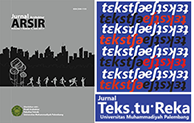Konsep Ruang Sakral dan Profan Pasar Gawok
Sari
The purpose of this study examines the concept of the sacred space and profane of Gawok market Sukoharjo which was formed and grew because of the beliefs held between the Gawok community and the previous King Kasunanan. From this belief, traditions and cultures are created, such as the determination of the Pon market day, the Angon Putu Tradition, the Sesajen Jum’at Ritual, the Kulo Nuwun Ritual, the Nyuwun Pitedah Ritual, and the Ngubur Blanjan Ritual. Qualitative research methods are used to explore and observe research objects in depth and then describe the state of cultural traditions such as places, social behavior, activities, market activities that are not yet known specifically for analysis of the influence of the concept of sacred and profane spaces that form a market tradition. The result of this concept is to create a local cultural identity and character of local wisdom and the noble norms of the Gawok market to make the market survive and exist until now amidst current penetration and modernization.
Kata Kunci
Teks Lengkap:
PDF (English)Referensi
Carey,Peter.2014. Takdir Riwayat Pangeran Diponegoro 1785-1855 (Edisi Peta Perang Jawa). Jakarta:Kompas
Effendi, Nursyirwan.2017. Studi Budaya Pasar Tradisional dan Perubahan Gaya Hidup Masyarakat Pedesaan : Kasus Pasa Nagari dan Masyarakat Nagari di Provinsi Sumatera Barat. JURNAL ANTROPOLOGI.18(2):105-120_ISSN 1410-8356. Diambil dari http://jurnalantropologi.fisip.unand.ac.id/index.php/jantro/article/view/61
Digdoyo, Eko. 2015. Ilmu Sosial dan Budaya Dasar. Bogor: Ghalia Indonesia
Junianto.2016.Konsep Mancapat-Mancalima Dalam Struktur Kota Kerajaan Mataram Islam-Periode Kerajaan Pajang sampai dengan Surakarta.ISBN,978-602-73308-1-8. Diambil dari : http://digilib.mercubuana.ac.id/manager/t!@file_artikel_abstrak/Isi_Artikel_712966813948.pdf
Koentjaraningrat.1996.Pengantar Antropologi. Jakarta: Rineka Cipta
Kinara J. You Tube ( 2018, Agustus 30). Tradisi angon putu pasar Tawangsari Sukoharjo. Diambil dari https://www.youtube.com/watch?v=duI6RLPko-I.
Lexy J. Moleong, 1994, Metode Penelitian Kualitatif. Bandung: PT Remaja Rosdakarya
Lombar, Denis.2008. Nusa Jawa Silang Budaya II. Jakarta:Gramedia Pustaka Utama
Muhammad, Noer Drs. DKK.1993. Peranan pasar pada masyarakat pedesaan di Daerah Riau. Depdikbud Riau.
Nastiti, Titi Surti. 2003. Pasar di Jawa pada Masa Mataram Kuno. Jakarta: Dunia Pustaka Jaya.
Rizal J.J, 2012, Menguak Pasar Tradisional Indonesia, Kementrian Pendidikan dan Kebudayaan. Direktoral Internalisasi Nilai dan Diplomasi Budaya, Direktorat Jenderal Kebudayaan, 65.
Sujiyo, Miranto.2016. Tinjauan Fungsi Ekologi Alun-Alun Tradisional Jawa.ISBN 978-602073551-0-8. Diambil dari : http://repository.uinjkt.ac.id/dspace/bitstream/123456789/34016/1/Sujiyo%20Miranto.pdf
Suhartono.1991. Apanage dan Bekel : Perubahan Sosial di Pedesaan Surakarta 1830-1920.Yogyakarta:Tiara
DOI: https://doi.org/10.32502/arsir.v3i2.1950
Refbacks
- Saat ini tidak ada refbacks.
Indexed by:

Arsir : Jurnal Arsitektur is lisenced under a Creative Commons Attribution-ShareAlike 4.0 International License.









